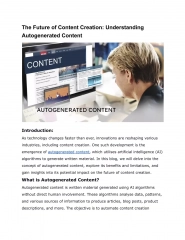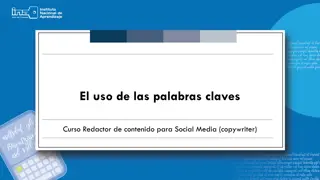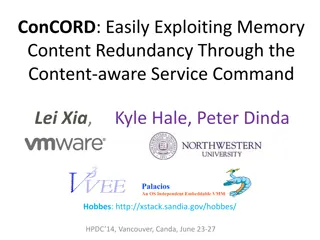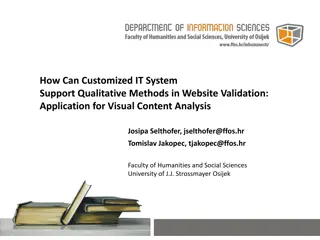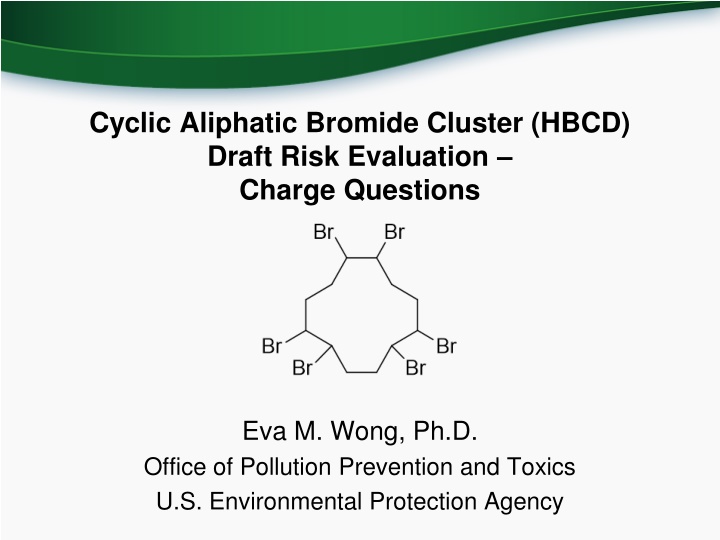
HBCD Draft Risk Evaluation and Assessment
Explore the EPA's draft risk evaluation of Cyclic Aliphatic Bromide Cluster (HBCD) focusing on content clarity, systematic review methods, and environmental fate considerations for human and wildlife exposure. Provide feedback and recommendations for enhancing the evaluation process.
Download Presentation

Please find below an Image/Link to download the presentation.
The content on the website is provided AS IS for your information and personal use only. It may not be sold, licensed, or shared on other websites without obtaining consent from the author. If you encounter any issues during the download, it is possible that the publisher has removed the file from their server.
You are allowed to download the files provided on this website for personal or commercial use, subject to the condition that they are used lawfully. All files are the property of their respective owners.
The content on the website is provided AS IS for your information and personal use only. It may not be sold, licensed, or shared on other websites without obtaining consent from the author.
E N D
Presentation Transcript
Cyclic Aliphatic Bromide Cluster (HBCD) Draft Risk Evaluation Charge Questions Eva M. Wong, Ph.D. Office of Pollution Prevention and Toxics U.S. Environmental Protection Agency
Question 1. Content and Organization (Draft Risk Evaluation and Supplemental Files) EPA s Final Rule, Procedures for Chemical Risk Evaluation Under the Amended Toxic Substances Control Act (82 FR 33726) stipulates the process by which EPA is to complete risk evaluations under the Frank R. Lautenberg Chemical Safety for the 21st Century Act. To that end, EPA has completed a draft risk evaluation for HBCD. As part of this risk evaluation for HBCD, EPA conducted an assessment of potential environmental, occupational, consumer, and general population exposures. The evaluation considered reasonably available information, including import, processing, distribution in commerce, use, and disposal information. It is important that the information presented in the risk evaluation and accompanying documents are clear and concise and describe the process in a scientifically credible manner. Q 1.1 Please comment on the overall content, organization, and presentation of the draft risk evaluation of HBCD. Q 1.2 Please provide suggestions for improving the clarity of the information presented in the documents. 2
Question 2. Systematic Review (Section 1.5 and supplemental documentation) To meet the scientific standards required by TSCA, EPA applied systematic review approaches and methods to support the draft risk evaluation of HBCD. Information on the approaches and/or methods is described in the draft risk evaluation as well as several supplemental documents. Q 2.1 Please comment on the approaches and/or methods used to support and inform the gathering, screening, evaluation, and integration of data/information used in the Draft Risk Evaluation for Cyclic Aliphatic Bromides Cluster (HBCD). Q 2.2 Please also comment on the clarity of the information as presented related to systematic review and suggest improvements as warranted. 3
Question 3a. Environmental Fate and Transport (Section 2.1) Use of HBCD Bioconcentration Factors (BCF) and Bioaccumulation Factors (BAF) Field measured HBCD BAF values in upper trophic level fish from heavily industrialized areas of China (He et al. 2013, Wu et al. 2010) and laboratory BCF values from edible portions of rainbow trout from Drottar and Krueger (2000) were used to estimate potential human and wildlife exposure through fish ingestion. BAFs were preferentially used because they represent exposure to the chemical through aqueous and dietary routes. The BCF study was selected to supplement the estimations because it was a guideline study conducted on an upper trophic level edible species. Q 3.1 Please comment on the use of field measured BAF values for upper trophic level fish from (He et al., 2013) and (Wu et al., 2010) for use in assessing human or wildlife exposure via fish ingestion. Q 3.2 Please provide any specific suggestions or recommendations for alternate approaches that could be considered for accounting for bioaccumulation of HBCD into food webs/diet of humans or wildlife. Q 3.3 Please also comment on the use of the BAF data from Chinese predatory fish species to address human exposure via fish ingestion. 4
Question 3b. Environmental Fate and Transport, continued (Section 2.1) Selection of HBCD Environmental Half-Lives for Use in Draft Risk Evaluation A wide range of degradation half-lives have been reported for HBCD in aerobic and anaerobic soil and aerobic and anaerobic sediment and were reviewed for the Draft Risk Evaluation Table 2-1, Section 2.1.3, Appendix C1, Appendix C3. The selected half-lives (Table 2-2) were used as inputs to environmental and human exposure models. Three studies addressing 5 biodegradation endpoints were used to derive half-lives and were selected based on the relevance of the biodegradation studies to the environmental compartment HBCD is expected to be released or partition to, i.e., water, aerobic soils and sediments. Q 3.4 Please provide any specific suggestions or recommendations for alternate approaches to derive media specific degradation half-lives for use in exposure assessments from data sets where values for the same environmental fate endpoint (e.g., biodegradation half-life in aerobic soil) vary widely. 5
Question 4. Environmental Release (Section 2.2) EPA used a combination of estimation methods and approaches to estimate releases for the various conditions of use (COU). Key environmental release data and data sources that informed the assessment of environmental releases include: release data from the European Communities HBCD risk assessment reports, USEPA Toxics Release Inventory (TRI) data, and Organization of Economic Co-Operation and Development Emission Scenario Documents (OECD ESDs) and USEPA Generic Scenarios (GSs). Q 4.1 Please comment on the methods and approaches used for environmental release estimation. Q 4.2 Please provide any specific suggestions or recommendations for alternative data sources, or estimation methods that could be considered by the Agency for conducting environment release assessment. 6
Question 5. Occupational Exposure (Section 2.4.1) Workers and occupational non-users may be exposed to HBCD when workers perform activities associated with the identified conditions of use. Example activities include: Handling of HBCD during repackaging or during transfer to storage or process vessels Machining and shaping of HBCD-containing XPS/EPS foam at industrial sites Cutting or breaking HBCD-containing XPS/EPS foam at construction and demolition sites Approaches for estimating occupational exposure include use of monitoring data and modeling, including methods used in EPA s TSCA New Chemicals Program. Key data and data sources that informed the occupational exposure assessment include monitoring data reported in the European Communities HBCD Risk Assessment Report, data from the Bureau of Labor Statistics (BLS), Organization of Economic Co-Operation and Development Emission Scenario Documents (OECD ESDs) and USEPA Generic Scenarios (GSs). Q 5.1 Please comment on the estimation methods and approaches used for occupational exposure assessment. Q 5.2 Please provide any specific suggestions or recommendations for alternative data, or estimation methods that could be considered by the Agency for conducting occupational exposure assessment. 7
Question 6. Environmental, General Population, and Consumer Exposure (Sections 2.3 and 2.4.2) Given the identified conditions of use, both monitoring and modeled data were used for estimating environmental, general population, and consumer exposures. Key sources were identified for integrating relevant monitoring data and three tools were used to estimate HBCD in surface water, sediment, soil, and exposures to wildlife. These tools include the Exposure Fate Assessment Screening Tool (E-FAST), Variable Volume Waterbody Model - Point Source Calculator VVWM-PSC, and Integrated Indoor-Outdoor Air Calculator (IIOAC). Key inputs for these exposure modeling tools come from scenario-specific processing data as well as receptor-specific exposure factors and human activity patterns. 8
Question 6. Environmental, General Population, and Consumer Exposure, Continued (Sections 2.3 and 2.4.2) Q 6.1 Exposure modeling tools may have different levels of screening capacity such that one might be more conservative than another given the scenario and inputs. Please comment on EPA s approach to use a tiered method for identifying and prioritizing exposure scenarios to be subjected to higher screening level modeling tools, based on their potential for risk by first using a lower screening level tool. Q 6.2 Please comment on EPA s approach to use receptor-specific exposure factors and activity patterns to estimate doses. Q 6.3 Surveys have identified fish consumption rates far above those used in this risk evaluation to estimate dietary exposure for subsistence fishing populations. Please comment on the use of such information in estimating the contribution of fish and other aquatic life to dietary exposure to HBCD. Q 6.4 Exposure modeling results may rely on various estimated inputs and ranges (e.g., physical-chemical properties) given the available data, which results in variability and uncertainty in the results. Please comment on EPA s approach to qualitatively characterize variability and uncertainty for exposure estimates in Tables 2-111 and 2-112. 9
Question 7. Environmental Hazard (Section 3.1) The environmental hazard of HBCD has been examined in several publications. The chemical has been categorized as persistent, bioaccumulative, and toxic. This assessment addresses HBCD environmental exposure to aquatic and terrestrial organisms and it s trophic transfer potential. Q 7.1 Please comment on the methodologies used to evaluate potential HBCD trophic transfer in aquatic and terrestrial ecosystems. Q 7.2 What other information can be incorporated into the evaluation? The available data on field studies on HBCD toxicity are limited, as presented in Risk Evaluation for Cyclic Aliphatic Bromides Cluster (HBCD), Systematic Review Supplemental File: Data Extraction Tables for Environmental Hazard. Q 7.3 Please comment on the use of mammalian studies, which were evaluated using human health metrics through the Systematic Review process, in the evaluation of HBCD risk to wildlife mammals. 10
Question 8. Human Health Hazard (Section 3.2) EPA considered the adverse human health effects for HBCD across organ systems and screened to those that are relevant, sensitive, and found in multiple studies. The HBCD human health hazard systematic review process screened 1,890 studies and obtained 53 studies that were relevant and applicable to the PECO statement. Only two of these studies were unacceptable based on data evaluation criteria. The remaining database of 51 studies included epidemiological studies that examined associations between HBCD exposure and endpoints related to effects on the thyroid, nervous system, and female reproductive system as well as repeat-dose experimental animal studies. EPA examined dose-responses for the endpoints of thyroid effects, liver effects, male and female reproductive effects, developmental toxicity, neurotoxicity, and immunotoxicity. Data on toxicity following acute exposures, irritation, sensitization, genotoxicity, and carcinogenicity were also considered. From these effects, EPA selected endpoints supported by the weight-of-evidence for non-cancer that were amenable to quantitative analysis for dose-response assessment and identified the appropriate toxicological studies to be used for acute and chronic exposure scenarios. 11
Question 8. Human Health Hazard, Continued (Section 3.2) In the systematic review of key studies, numerous studies were identified as ranking high in the quality review. EPA selected PODs for critical effects from two key studies: (WIL Research, 2001) and (Ema et al., 2008), to carry forward for dose-response analysis and risk estimations. Q 8.1 Please provide comment on whether there are other comparable high- quality studies that might be recommended for further consideration for dose- response for additional critical effects and for acute or chronic exposure scenario consideration. 12
Question 8. Human Health Hazard, continued (Section 3.2) EPA considered both developmental toxicity endpoints of reduced pup weight and offspring loss for estimating risks following acute oral exposures to HBCD in the general population (risk estimates were shown for the most sensitive endpoint of offspring loss). While these neonatal effects are not traditionally associated with acute exposures, the long half-life of HBCD suggests that even a single exposure may result in a retained body burden for an extended period of time. Additionally, evidence from other thyroid disruptors suggests that acute or short-term exposure can result in thyroid hormone effects (Paul et al., 2010; Hedge et al., 2009; Zhou et al., 2001), including in weanlings, and presumably resulting in downstream effects on developmental endpoints. EPA considered both endpoints relevant for estimating risks following acute general population exposures. Q 8.2 Please comment on EPA s justification in the document for consideration of developmental toxicity risks following acute exposures. 13
Question 8. Human Health Hazard, continued (Section 3.2) These developmental toxicity endpoints may only be relevant to child-bearing age groups in the general population. The endpoint of offspring loss was only observed in the F2 generation in a two-generation reproduction toxicity study (Ema et al., 2008), suggesting a multigenerational effect (possibly due to increasing bioaccumulation) over repeated/chronic exposures. However, while developmental effects would not be expected to present in younger lifestages, the bioaccumulation and persistence of HBCD in tissues suggests that initial exposure at an earlier age could result in effects later in life. Additionally, it is unknown whether developmental effects on neonates could also present in young exposed children (i.e. decreased weight). Q 8.3 Please comment on EPA s justification in the document for consideration of developmental toxicity risks in all age groups.. 14
Question 8. Human Health Hazard, continued (section 3.2) EPA estimated risks for effects on thyroid hormones only following chronic exposure. However, evidence from other thyroid disruptors suggests that acute or short-term exposure can potentially result in thyroid hormone effects (Paul et al., 2010; Hedge et al., 2009; Zhou et al., 2001). Q 8.4 Please comment on whether EPA should consider thyroid hormone effects as an acute endpoint. 15
Question 8. Human Health Hazard, continued (section 3.2) In the study by (Ema et al., 2008), the increased incidence of non-pregnancy in HBCD- exposed F0 or F1 rats alone was not statistically significant with either pairwise test (as reported by authors) or Cochran-Armitage trend test (conducted by EPA). Dose- response curves were shallow and never reached a high response percentage. The results of several statistical tests indicated that F0 and F1 datasets were compatible for combining. Therefore, EPA considered this change to be biologically relevant and the log-logistic model (which only demonstrated adequate fit after dropping the highest dose) from the combined dataset was selected to derive the BMDL for this chronic endpoint. Q 8.5 Please comment on EPA s justification and approach to modeling this chronic endpoint based on the data available in (Ema et al., 2008). Q 8.6 Please comment on the evaluation of human health hazards and weight-of-evidence characterization. Q 8.7 Are there any additional HBCD specific data and/or information that should be considered? Q 8.8 Please comment on any other aspect of the human health hazard assessment that has not been mentioned above. 16
Question 9. Environmental Risk Characterization (Section 4.1) EPA considered use of different model assumptions and ecological considerations in its establishment of RQs (e.g. flow rate, partitioning in environmental media, percentage of HBCD removal from direct releases, etc). Q 9.1 Please comment on the appropriateness of EPA's selections for deriving RQs. EPA considered the use of KABAM (U.S EPA, 2009), a model used by the Office of Pesticide Program, to estimate potential bioaccumulation of HBCD in freshwater aquatic food webs to provide information regarding HBCD trophic transfer using predicted surface water and sediment concentrations (E-FAST and PSC), in order to relate HBCD exposure to specific conditions of use. Q 9.2 Please comment on the appropriateness of using this methodology for characterizing risk. 17
Question 10. Human Health Risk Characterization (Section 4.2) EPA evaluated integrated risk estimates for the general population in order to account for individuals who are chronically exposed across multiple lifestages. Exposure scenarios include central tendency (13 year) and higher end (33 year) periods of residential mobility, based on the Exposure Factors Handbook values. MOEs were integrated across each lifestage as a weighted average. Q 10.1 Please comment on EPA s approach. Physiologically based pharmacokinetic (PBPK) models would be needed in order to be able to accurately estimate bioaccumulation of HBCD in human tissue for different exposure durations over time. Some simplistic models for HBCD exist (empirical two-compartment open kinetic model; and a simple first-order elimination model to estimate the steady- state lipid concentration); however, these models introduce significant uncertainties that reduce the value of their use. Based on the absence of a robust peer reviewed PBPK model for HBCD, EPA relied on the application of default uncertainty factors for interspecies, intraspecies uncertainty factor and subchronic-to-chronic from subchronic exposure studies. Q 10.2 Please comment on EPA s approach. 18
Question 11. General Risk Characterization (Sections 4.1 and 4.2) After consideration of all information identified by EPA that pertains to HBCD, EPA concluded that HBCD does not present an unreasonable risk of injury to health or the environment. EPA made these determinations considering risk to potentially exposed and susceptible subpopulations identified as relevant, under the conditions of use without considering costs or other non-risk factors. Q 11.1 Please comment on the objectivity of the underlying data used to support the risk determinations and the sensitivity of the agency's conclusions to analytic assumptions made. Q 11.2 Please comment on the characterization of uncertainties and assumptions including whether EPA has presented a clear explication of underlying assumptions, accurate contextualization of uncertainties and, as appropriate, the probabilities associated with both optimistic and pessimistic projections, including best-case and worst-case scenarios. 19
Question 11. General Risk Characterization, continued (Sections 4.1 and 4.2) Q 11.3 Please provide information on additional uncertainties and assumptions that EPA has not adequately presented. Q 11.4 Please comment on whether the information presented supports the findings outlined in the draft risk characterization section. If not, please suggest alternative approaches or information that could be used to develop a risk finding in the context of the requirements of the EPA s Final Rule, Procedures for Chemical Risk Evaluation Under the Amended Toxic Substances Control Act (82 FR 33726). 20

